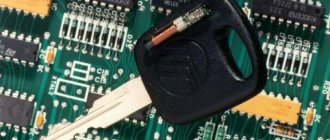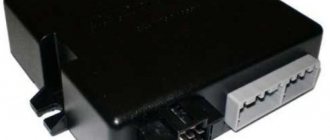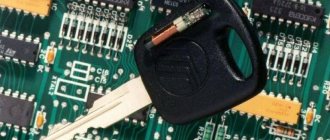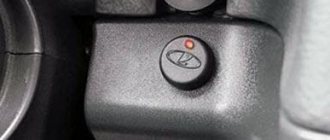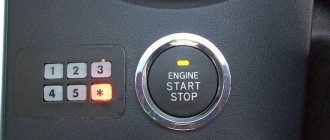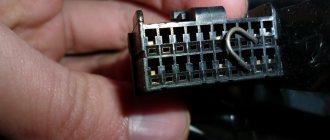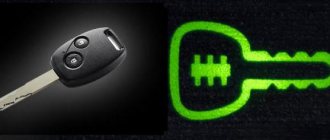02/04/2022 7,760 VAZ 2115
Author: Ivan Baranov
All modern cars, including vehicles of the domestic automobile industry, are equipped with immobilizers. Immo is an anti-theft device that allows you to block the engine in the event of a car break-in. But like any other electronic device, over time this device may break down or begin to “glitch”; in such cases, car owners are faced with the need to turn it off. How to disable the immobilizer on a VAZ 2115 with your own hands - we will talk about this below.
[Hide]
How to quickly, easily, and most importantly correctly disable the immobilizer on a VAZ 2115?
All modern cars, including vehicles of the domestic automobile industry, are equipped with immobilizers. Immo is an anti-theft device that allows you to block the engine in the event of a car break-in. But like any other electronic device, over time this device may break down or begin to “glitch”; in such cases, car owners are faced with the need to turn it off. How to disable the immobilizer on a VAZ 2115 with your own hands - we will talk about this below.
General information
To begin with, it will be useful to find out where the immo is located, because if this device does not work, to disable it you need to gain physical access to the device. In VAZ 2115 cars, the immo is located behind the center console, to the right of the steering wheel.
Today there are two types of devices - contact and non-contact. Contact systems are controlled using keys, while contactless systems are controlled using special chips built into a key fob or card. In the case of VAZ cars, immos are installed only on injection versions of cars.
Principle of operation
The operating principle of this device is based on data exchange between the control unit and the immo. The anti-theft device transmits data to allow or prohibit the start of the power unit. If prohibited, the system automatically blocks the ignition circuit with the fuel pump, and accordingly, starting the engine will be impossible. That is, without initialization the power unit will not be able to start.
In what cases should it be disabled?
In what cases do you have to disable the anti-theft installation:
- If you are dealing with a manufacturing defect, that is, a defect. In particular, we are talking about the first versions of cars on which such devices were installed. In later variations, VAZ engineers added the function of alternative engine start, bypassing the protection. But you need to take into account that in this case the option will work only once - if a failure occurs, you must enter the access code, then activate the function and press the gas pedal a certain number of times. Moreover, this operation will need to be repeated 6 times. For example, if your password is 123897, then first you press the pedal once, then twice (after a short period of time), then three more times, then eight times, etc. This function is described in more detail in the service manual.
- If the battery is completely discharged, the control unit may record this as an error, which will not allow the engine to start in the future. As mentioned above, the control module and the immobilizer interact with each other through a diagnostic line. So if the circuit loses power, it is perceived as an error.
- Also, blocking can be carried out due to the control unit. For example, if a driver uses diagnostic equipment to test vehicle systems, a code failure may occur. The ignition must be turned on. Moreover, the cause of the failure may also be due to interference emitted by the smartphone.
- Also, the need to bypass immo may arise as a result of banal failures in its operation (the author of the video is the IZO channel)))LENTA).
What is engine blocking with a car alarm?
The vast majority of anti-theft alarms, among their numerous security functions, also contain the ability to block the engine. As a rule, a standard immobilizer is responsible for this, the task of which is to identify the real owner of the vehicle and, if successful, unlock the power unit. But the same function is also equipped with purchased alarms installed in a car in addition to standard equipment or in their absence.
According to statistics, over 50% of cases of engine failure are associated with one or another malfunction of the car alarm. It is worth noting that the complexity of unlocking the engine in such cases is an order of magnitude simpler than in the presence of complex integrated anti-theft systems. So if you have a regular alarm installed, the chances of unlocking the power unit on your own are quite high. Of course, if you have a good understanding of how a specific implementation of the system works and what should be done to fix the problem.
In any case, anti-theft systems, standard or installed after purchase, operate under firmware control and are part of the vehicle’s electrical equipment. The reasons for their malfunction are rarely due to mechanical failures: much more often, electronics fail, and such failures can be isolated or frequent, almost constant. It is advisable not to let things get to the last point, because the sooner a problem is discovered, the easier it will be to diagnose and fix it. You also need to understand that the severity of the malfunction will not correlate in any way with the specific make/model of the vehicle - everything will depend on how complex the implementation of the anti-theft system is.
Can accidental activation of the alarm functions prevent the engine from starting? Of course, therefore, first of all, you should check the condition of the key fob for the presence of atypical pictograms or inscriptions
If there is a warning light (LED indicator light), you should pay attention to its behavior. Thus, rapid blinking will indicate that the immobilizer anti-theft mode is activated
Let's look at methods for diagnosing StarLine car alarms. If, when you turn on the ignition, the starter does not start, the warning light begins to flash rapidly and at the same time the immo message appears on the key fob:
- you need to try to pull the key out of the central locking and then press the central locking key on the key fob;
- the second option is to get out of the car, sequentially turn on and off the security function and then try to start the engine.
Both actions are aimed at ensuring that the security system is operating as normal. Every third case of blocking occurs due to unintentional interference with software settings. If you suspect this, you should sequentially disable all additional modes.
StarLine is characterized by the presence of a two-component unlocking function, and the activation of this mode often occurs accidentally. In such cases, you can unlock the car alarm by holding down button 3 for several seconds until two sound signals are issued in the form of two short squeaks. Then you need to press three (short) and one (long) again. As you can see, the algorithm is quite complex, and on other anti-theft systems it can be implemented completely differently.
Instructions for disabling immo
If your car is equipped with an alarm or central locking, then you don’t have to worry about the safety of the car when the immo is turned off. If you do not know how to turn off the alarm, then this procedure is carried out using the service button, which is usually called Valet. The shutdown procedure is described in more detail in the service manual. We will not describe it, since it is individual for each individual car model.
As for immobilizers, they are disabled according to the following principle:
- First you need to disconnect the control unit connector.
- Next, you need to dismantle the control unit; to do this, unscrew the side covers in the so-called doors on the console using a screwdriver, then disconnect the terminals and remove the device.
- Now you need to read the EPROM. EPROM is a non-volatile memory; it is needed because it contains data on the operation of the anti-theft device. After completing the work, the EPROM is installed in place.
- After this, you need to disconnect the PAK loader from the control module.
- Disconnect the module so that the device is not automatically blocked during installation.
- Next, we proceed to dismantling the immobilizer itself. As mentioned above, it is located behind the center console, in the area of the steering wheel. The block is located at the audio system level.
- You need to feel and disconnect the plug with your hand; there are 20 contacts on it. Having done this, you can begin to restore the K-Line, for this you will need to close the contacts on the connector, in particular, we are talking about outputs 9 and 18. That is, they must first be cut and then insulated. Having done this, reinstall the block and try to start the engine. If you did everything correctly, the engine will start.
Manipulations with the ECU controller
The VAZ-2114 controller unit may belong to the following family - January 5.1.X or ITELMA 5.1. The digital designation printed on the label in this case looks like this: 2111-1411020-71 (the numbers “72” may appear). If the last two digits are a “space” or the number “70,” it means that the BOSCH M1.5.4 controller is installed. In the latter case, erasing the EEPROM involves disassembling the block, but without soldering. And in the first case, you don’t even have to open the block cover.
Resetting EEPROM in a BOSCH controller
Let's see what the controller board looks like from below:
ECU BOSCH M1.5
The 24C02 chip is the EEPROM memory. Circle the 5th and 6th taps, B and C, with a marker. These points are intended for connecting the programmer, which is assembled from three transistors.
The programmer circuit in question looks trivial. This means you can quickly assemble it with your own hands:
Programmer for EEPROM 24C02
The device is connected to the COM port of the computer. And the voltage “12 Volts” is taken from the MOLEX connector. Of course, ground must also be taken from this connector. The maximum current consumed by the ECU will in any case not exceed 0.5 A.
Now let’s look at the procedure for allowing the ECU to “forget” about the existence of the immobilizer:
- The 18th and 27th contacts of the block are supplied with supply voltage (12 Volts);
- The common wire, that is, ground, is connected to pin 19;
- Wait 10 seconds;
- Connect contact B of the programmer to tap 5;
- Connect contact C of the programmer to tap 6;
- In the Combiset program interface, select the “Clear EEPROM” item, press the “Install” button;
- They wait a few minutes.
The wiring of the main ECU connector looks like this:
ECU block, 55 pins
The Combiset application must be downloaded from the official website (almisoft.ru). Even the Demo version, available in the Download section, is suitable.
In the program itself, you must correctly set the number of the COM port that will be used. The COM-1 port is shown below, but this is not the only option.
Combiset program interface
How “January” controllers are “untied”
A common type of controller in VAZ-2114 cars are the following blocks: January 5.1.X and ITELMA 5.1. They need to be programmed the same way. You need to use an adapter from the COM port to K-Line, but you can easily make it yourself:
Screenshot of the Flashecu program window
The erasing procedure takes several minutes.
General advice for everyone
The block itself, which was mentioned above and which needs to be “untied” from the immobilizer, is always located in one place - under the tunnel cover on the right:
Interior of the fourteenth model
Of course, we are talking about the 2114 family, and in other VAZ cars the unit will be more difficult to find. Installation and disconnection can be done as follows:
- Remove the negative terminal from the battery;
- Unscrew the fixing bolt and remove the clamp together with the block;
- Disconnect the connector.
During installation, the steps are carried out in reverse order. But there is one trick.
After connecting the ECU, power is supplied to the network. And then, oddly enough, you need to turn on the ignition and wait for the Check lamp to come on. And only then, turning off the ignition, can you continue operation.
Note that the immobilizer itself, after flashing the unit, should not even come into contact with the latter. Therefore, having disconnected its terminal block from the immobilizer, they carry out the standard modification:
- The wires are cut off from terminals 9 and 18;
- The resulting branches coming from the loop side are connected.
You don’t have to change anything, but simply disconnect the connector completely, losing some features:
- Polite lighting;
- PTF rear headlight control;
- Window control.
As you can see, the immobilizer in modern VAZ cars has many functions. And they turn it off for one purpose - to activate the alarm system with auto start.
Double-row connector for standard immobilizer
The immobilizer bypass module in any VAZ car works well in one case - when it is connected to a break in the antenna circuit. But not all factory-produced modules are designed for this connection option in principle.
as91 › Blog › VAZ immobilizer
Hi all. In the text I will mention the abbreviation ECU - electronic control unit. They are often called "brains". I won’t tell you what an immobilizer is, it’s written about in the previous post, let’s get straight to the point. Today I will talk about immobilizers APS-4 and APS-6. The abbreviation APS stands for: Automotive Anti-Theft System. Let's start with APS-4. APS-4 was installed on early VAZs sometime before 2007. Tens, chisels, etc. Works with MP7.0, M1.5.4 (Bosch) and January-5 ECUs. NOT installed on priors, viburnums, shnivy. They had APS-6, read about it below. I didn’t install it on classics at all. One of the design features is that the immo key is not located in the ignition key, but on a separate key fob, which must be brought to a special place on the panel to be read. By the way, there are quite a few articles on the Internet where people remade this key fob and built it into the key, rewinding the antenna to the ignition switch. This is what the APS-4 and keychains for it look like:
Immo began to be installed on VAZs from the moment the production of injection cars began, but there was a small lapse: when they started making injectors, it turned out that there weren’t enough immobilizers for everyone. I don't know why this happened. Either the plant couldn’t cope, or they were saving money, but among the first cars there were cars both equipped with an immobilizer and without it, although all the wiring for it was there - only the unit itself was missing. Because of this, a dilemma arose - what to do? The solution was ingenious - they decided to supply cars with an immoblizer, but not included in the car's ECU. That is, the box simply dangled in the wiring until the new owner decided to activate it. Accordingly, if there was no immo, there were no problems. Here is an example of how to activate the immobilizer, taken from the instructions for the APS-4 unit:
• Turn on the ignition, the APS LED lights up • Bring the red key • Turn off the ignition without removing the red key. • Short squeak. The APS LED should start flashing. • Bring 1 black key. • Squeak. The LED goes out temporarily. • Bring 2 black keys. • Squeak. The LED goes out temporarily. • Bring the red key. • Squeak. The LED lights up. • Turn on the ignition. • Squeak. The LED goes out. (On MP7.0 the LED continues to light. You must turn off the ignition no later than after 10 seconds.) • Turn off the ignition.
After activating the immobilizer, a code was written into the memory of the car's ECU and then worked with it. I note that the ECU, having not received the go-ahead to start from the immo, turned off not the injectors, but the fuel pump and ignition control. The next blunder was that if on a car with activated immo you put the brains from a car with not activated immo, then the car will start... If anyone wants to know whether their immo is activated, then here is an excerpt from the manual (applies only to APS-4) : The immobilizer training procedure is assigned to dealers, but unfortunately not all of them carry out this procedure. Therefore, for further actions it is necessary to be able to determine whether the immobilizer is clean or trained. This can be determined by the time the LED turns on in the standby state. The immobilizer is in the standby state (ignition is turned off, the driver's door is closed) after the interior lighting goes out. In this state, the LED flashes once every 2.5 seconds, but if the immobilizer is clean, then the time the LED is on is 0.5 seconds, and if it is trained - 0.1 seconds.
What to do if the immobilizer has blocked the engine from starting
Unlocking the immobilizer can be done in several ways, much depends on the type of device installed in a particular brand of car.
Common methods:
- Using an infrared transmitter;
- Using the central locking button.
Unlock using IR transmitter
The method, if the immobilizer has blocked the engine, is suitable for types of devices in which the central locking and immobilizer are controlled by an IR key, for example, like in Mercedes cars.
In this case, you will need a four-digit code, which is entered during the unlocking process by pressing the on-board computer button (hereinafter referred to as BC) while holding down the gas pedal. The button is located on the windshield wiper switch at the end (not on all cars).
Algorithm of actions:
- Activate the immobilizer and turn on the ignition;
- A flashing light on the instrument panel will indicate that engine starting is blocked;
- We remove the blinking of the lamp by squeezing the gas pedal;
- Find the BC button. Without releasing the gas pedal, press it as many times as the first digit of the code;
- Take your foot off the pedal and the lamp will start flashing again;
- We press the pedal again - by pressing the BC button we enter the second digit of the code.
- Let's release the pedal;
- We repeat the same steps two more times.
A constant light on the lamp, regardless of whether the gas pedal is depressed or not, will indicate that the immobilizer is unlocked and you can try to start the engine.
If the code was entered incorrectly, the immobilizer will block the engine again. Nothing bad happened, you have two more tries. If they were not successful, then after 15 minutes you can repeat them.
How to unlock using the central locking button
To unlock the immobilizer using the central locking control button, you will need to enter an emergency code.
It is important to understand that using the steps listed below you can only start the car, but not decode the computer and the solenoid valve.
Algorithm of actions:
- Turn on the ignition. The light on the instrument panel will flash slowly.
- Turn the ignition off and on again. The light will flash faster, other lights will appear and go out after 3 seconds.
- After pressing and holding the central button on the key fob, the lamp will flash more slowly.
- Carefully monitor the blinking process, it is important to count the flashes and when their number is equal to the first digit of the code, release the central button on the key fob.
- Press and hold the button again. We release it as soon as the number of blinks matches the second digit of the code.
- We repeat this two more times.
That's it, the immobilizer is unlocked and you can start the engine. But when the ignition is on, a lamp flashing every 3 seconds will indicate that the protection is disabled.
The immobilizer will be locked again, after which you will have to enter the code again if:
- You turn off the ignition for more than 10 seconds.
- Disconnect the battery.
- The device will be blocked for 5 minutes if the code is entered 3 times in a row with an error.
The device of the standard immobilizer APS-4
First, let's figure out what this immobilizer model is and what functions it performs. This kind of device is designed to prevent the engine of your car from starting in cases where access to it is recognized by the system as unauthorized, that is, in the event of a possible theft.
The standard APS-4 set includes a set of keys with an electronic code written on them (a pair of black ones are the main “working” ones, a red one is “programming”), an indicator sensor (a light bulb near the ignition switch) and a control unit that functions in conjunction with the electronic system car control. The code information recorded on the keys when “learning” the system is individual for each APS, and, as a rule, is installed when purchasing a car (you can learn more about “learning” working keys from the instructions included with the device).
Remember that the keys must be stored carefully - losing the red “training” key will deprive you of the opportunity to re-write working keys.
This can lead to a complete replacement of control and monitoring units in the event of malfunctions. When the ignition is turned off, the immobilizer is activated automatically (the buzzer will emit a short beep and the indicator will go into flashing mode every 2.5 seconds), entering the theft protection mode.
In order to activate the system, the information sensor must read information from the coded keys (you need to bring them to the ignition switch so that the system can recognize the “native” key). Only after this will the blocking of the electrical circuit be turned off and access to starting the engine will be provided. Otherwise, the car simply will not start.
Joke from AvtoVAZ
Important! When disassembling the immobilizer yourself, pay attention to the markings of its boards. The fact is that the case from APS-4 may contain a board from the 6th series. This is another, another cruel joke from AvtoVAZ
This is another, another cruel joke from AvtoVAZ.
VEHICLE ANTI-THEFT SYSTEM (APS)
The car is equipped with an APS-4 car anti-theft system (immobilizer), consisting of a control unit, a system status indicator and code keys.
The immobilizer is an electronic unit that prevents unauthorized engine starting, opening the necessary electrical circuits and works in conjunction with the electronic engine control system.
The immobilizer goes into security mode automatically when the ignition is turned off.
Checking the activity of the anti-theft system
First of all, make sure that the anti-theft system is connected and inactive. To do this, close all the car doors except the driver's door, get into the car and close the driver's door. The interior lamp should continue to light after closing the driver's door for another 12 seconds, and then go out smoothly. Turn on the ignition, the system status indicator LED should light up and stay lit while the ignition is on. In this case, you can proceed to the procedure for transferring the anti-theft system to the active state, i.e. carry out the so-called “training” of the system with code keys, which then become individual for each anti-theft system.
If, when the ignition is turned on, the system status indicator LED blinks at a frequency of 2 times per second, this means that the anti-theft system of your car has already been switched to an active state.
Disarming the immobilizer
To disarm the anti-theft system and start the engine, do the following.
1. Open and close the driver's door or turn on the ignition. In this case, the system goes into the “reading” mode of the key code, and the system status indicator LED on the instrument panel begins to blink at a frequency of 2 times per second. If the transition to the “reading” mode is carried out by turning on the ignition, the buzzer will emit a short sound signal.
2. In the “reading” mode, which lasts 1.5 minutes if the door was manipulated, or 10 seconds if the ignition was turned on, you should bring “your” working key to the indicator. After the system reads and recognizes the key code, the LED goes out and the buzzer emits a double beep. When the LED turns off, the engine can be started.
3. Turn on the ignition, the LED will light up briefly and go out, the engine should start.
The anti-theft system switches to security mode automatically after turning off the ignition and depends on the situation and the actions of the driver. If the driver’s door did not open or was open and not closed, then arming occurs after 5 minutes; If the driver's door was opened and closed, then arming occurs 30 seconds from the moment the door is closed.
In all cases, 15 seconds before arming the system, the buzzer starts beeping at an accelerating pace. If arming is not desired, then you must turn the key to the “ignition” position.
If, when you turn on the ignition, the system status indicator LED does not light up, but flashes at a frequency of 1 time per second for 20 seconds, this means the following:
1) there is no electrical connection between the engine control controller and the immobilizer unit. Check the connection in the engine control system harness;
2) the engine control controller was previously “trained” with code keys from another immobilizer unit. The engine will not start. Contact a service station;
3) if, when the ignition is turned on, the LED does not light up and blinks at a frequency of 5 times per second for 20 s, this means an error in the immobilizer unit. If this flashing does not stop even when the ignition is turned on again, you must contact a service station.
Immobilizer “learning” procedure
If you are convinced that the anti-theft system is in an inactive state, you can proceed to the procedure for “learning” (coding) code keys. To do this, follow these steps:
1. Turn on the ignition. The LED of the system status indicator should light up with a steady, non-flashing light no later than 5 s.
Possible performance problems
Unfortunately, sometimes immobilizers begin to malfunction, causing significant trouble not only to potential car thieves, but also to the legitimate owner of the car.
The code reading system is quite vulnerable to external digital interference, and therefore even trivial interference, caused, for example, by cellular communications or car diagnostic devices connected externally, can cause it to malfunction. At first, there were often cases of manufacturing defects when the system simply stopped working for no apparent reason. You also need to carefully monitor the maintenance of your battery in working condition (especially in case of long periods of downtime in the cold season) - a complete discharge of the battery is guaranteed to force you to seek help from the nearest workshop, followed by replacement of the electronic control unit of the anti-theft system, which will result in unnecessary additional expenses.
Methods for disabling the VAZ-2115 immobilizer
If you don’t have the skills to reprogram a security system, but don’t want to make charitable investments in favor of car services, that’s okay. The solution to the potential problem is quite simple: you can disable the standard immobilizer yourself. It is worth considering that this is recommended only in cases where your VAZ-2115 already has an alternative anti-theft system installed, otherwise you will simply give the green light to attackers.
So, in order to deactivate APS-4 without self-flashing and provide unhindered access to the engine, you need to do two things: completely dismantle the immobilizer itself and erase the security coding data from the memory of the car’s electronic control unit. This procedure must be carried out carefully: there is a risk that the system will regard this intervention as an attempt to steal a car and block further access.
Polite lighting and door switches
Any alarm or security system is always equipped with an input connected to the door limit switches. In VAZ cars, the control wire can be connected to one point (A). Diodes are not used in this case:
Door control connection diagram
Be sure to carry out the setup: the delay in polling the limit switches should be 20-30 seconds. If this is not done, false alarms will occur when the security system is turned on. The reason is the operation of the APS unit, which does not turn off the light after the driver's door is closed. The option in question is called “polite backlighting.”
In theory, pins 7 and 13 of the BSK are the connection points that need to be decoupled by two diodes. But as practice shows, it is better to implement a circuit with three additional diodes (see figure). The alarm is connected to point B, and setting the polling delay in this case is not required. Good luck.
Disabling the immobilizer in emergency situations
To combat car thieves, the introduction of special devices that prevent unauthorized engine starting is a reasonable step for automakers. But here there is a traditional “race between armor and projectile” - as soon as a new anti-theft system appears, the search for ways to bypass it immediately begins.
On budget cars, disabling the immobilizer is so simple that it is not a problem for car thieves at all: all you need to do is gain access to the diagnostic connector. Standard VAZ immobilizers (especially APS-4) have become famous more for the problems they cause to their owners than for the reliability of their protection. At least in topics like “The immobilizer does not turn off” on specialized forums, the most common recommendation is one - turn it off completely.
As an example, let's take the connection diagram of the APS-4 block
“Communication” between the immobilizer unit and the injection ECU when starting is allowed goes through a low-speed K-line, which does not have serious noise protection. Therefore, problems with starting were even caused by interference from a cell phone, not to mention attempts to start a car with a low battery, when the APS unit entered a completely random set of data into the memory of the injection ECU. After this, starting the engine became impossible until the device learning procedure was completely completed. Without a training key it was impossible to complete it at all, so disabling the immobilizer became a reasonable step.
The number of problems with the standard immobilizer on the VAZ 2113-2115 family, where the APS-4 was installed, reached such a magnitude that even the plant developed a user-programmable procedure for unlocking a “stuck” immobilizer, and many owners preferred to disable it completely.
Dialogue between immobilizer and injection computer
For APS units, as well as for other standard immobilizers, communication with the injection control unit is simple. At the moment of “training” of the immobilizer, when key codes are written in its memory, the code of the device block itself is simultaneously written in the memory of the injection ECU. After the training procedure, the immobilizer will “accept” only the registered keys, and the injection ECU will “wait” for permission only from “its” device.
If no code is entered into the corresponding memory cells of the injection ECU, then the “brains” will not wait for permission to start at all. Therefore, it is possible to disable the immobilizer without removing the injection computer if the control unit supports flashing via the diagnostic connector. For such cars, car thieves usually took with them spare “brains” - new ones, where the immobilizer had not yet been registered, or “wiped out”.
At the same time, bypassing the standard immobilizer in this way did not cause any problems with the rest of the electronics - in the standard wiring, the APS is embedded in the gap of a single bus between the diagnostic connector and the “brains”. Therefore, deactivating the immobilizer in this way only deprived the subsequent possibility of diagnosing the injection computer, and even then this problem was eliminated by a simple jumper in the connector of the APS unit.
What to do if the immobilizer does not see the key?
The immobilizer will block the engine if a failure occurs when reading the program code from the key or the required signal is not detected.
This may occur due to a design or technical error that is not related to the operation of the device's central board.
To solve the problem, try using a second key, perhaps the battery on the first one is dead, and also pay attention to the external antenna of the immobilizer, it may produce a signal weaker than necessary.
As a last resort, you will have to reflash the immobilizer module; before that, it needs a full diagnosis.
We will dwell on this topic in more detail below.
How to disable the immobilizer yourself?
If the standard immobilizer is blocked, then disabling APS-4 is quite simple. It is necessary to physically remove the immobilizer, delete information about it from the non-volatile memory of the injection computer, and then install a jumper in the immobilizer connector to restore the integrity of the diagnostic bus.
On cars of the “tenth” VAZ family, the APS is installed above the injection ECU, access to it is on the side of the center console near the pedal assembly. For the “ninth” and later “fifteenth” family of VAZ cars - behind the instrument panel, in the area of the steering column.
After the APS-4 is physically switched off, the regular smooth dimming of the interior lamp light will stop working. Since disabling the immobilizer is essentially just breaking its connection with the injection computer, you don’t have to remove the unit itself, but simply remove pins 9 and 18 from its connector, connecting them “past the immobilizer.”
The unit is now physically disconnected from the injection ECU, but the ECU is still waiting for a signal from it to allow start. Therefore, now you need to clear the EEPROM of the ECU, which is more convenient to do on units of the “January 7.2” type, where for this it is enough to assemble a simple device-programmer from two “crocodiles” to supply power and “ground” to the removed control unit, a Chinese “cord” VAG- COM from Aliexpress and several pads (for example, cut from old computer power supplies - the power pads are just suitable for drives for 3.5” floppy disks that have not been used for a long time). Pins 12, 13, 43, 44, 63 are supplied with “plus”, pins 51, 53 and the body of the unit itself are “ground”, the K-line from the adapter is connected to pin 71.
In many programs for working with injection ECU memory, disabling the immobilizer is as simple as possible - in the ChipLoader program, all you need to do is read the EEPROM from the controller, click the “Delete immo” button and upload the processed memory dump back into the controller.
Old “Bosch” control units are much less convenient in this regard, since they do not provide easy access to the EEPROM. They have to work directly with a non-volatile memory chip through a special programmer - not the best solution for doing it yourself.
How to remove the immobilizer on later VAZ models? Here it has already been improved, including the appearance of control of the standard central locking from radio keys. Therefore, it is no longer possible to physically remove the APS here, since the central locking will also cease to function normally (similar problems are possible when installing a used immobilizer unit on a car where another unit has already been trained). The engine control units themselves have also been modernized; reprogramming them can no longer be done in such a “knee-jerk” way, so it’s worth turning to specialists.
Something else useful for you:
In more modern injection systems, removing the device is already much more difficult - if the old VAZ units worked calmly with a blank EEPROM, then in the future this obvious loophole for hijackers was eliminated at the level of the injection ECU program code. It will look for communication with the immobilizer block, and using a dynamic code, which makes simple substitution of blocks impossible.
On such cars, disabling the immobilizer is possible only by flashing the injection ECU with upgraded firmware, in which the code responsible for “communication” with the immobilizer has been removed. To create such firmware, a lot of work is required - you need to disassemble the finished machine code, understand its logic and make the correct modification. Therefore, even on a familiar Logan, disabling the immobilizer can cost several times more than on the same VAZ 10, and not all control units are handled by specialists.
Firmware for other keys
When the immobilizer has been unlocked, you can “bind” other keys. The general process is described below; it may differ slightly for each type of device. Information should be found in the instructions.
Algorithm of actions:
- Make sure that the immobilizer light on the instrument panel is not on;
- Turn on the ignition and immediately turn it off;
- Press the central locking control button on the IR key (the door locks will work).
You will have 15 seconds to:
- At intervals of 1.5 seconds, press the IR key button 2 times, the central locking should work. The IR key itself must be directed to the central control unit (signal receiver).
- This way we program other keys for the current immobilizer.
How to register a new key in Lada Kalina
- The car must be in neutral gear and the handbrake;
- Close the doors with central locking;
- Turn on the ignition with the master key (with the red mark) and wait 6 seconds.
- Turn off the ignition and insert a new key.
- Turn on the ignition again and wait for 3 beeps. They will be there right away. Then 2 more, they will come later. Total – 5.
- Turn off the ignition and remove the key.
- We insert the red master key and wait for the signals as in step 5.
- Turn off the ignition, but do not remove the key.
- We are waiting for a single signal. The immobilizer lamp should flash even more frequently.
- Turn on the ignition and turn it off after 2-3 seconds. The car should flash its low beams and beep. The lamp will stop flashing.
- Remove the master key without turning on the ignition.
- Wait about 10 seconds.
- We insert the new key, turn on the ignition and wait 6 seconds.
- We start the engine.
- Turn off the ignition, remove the new programmed key and check the remote control.
How to bypass the immobilizer on VAZ cars
Publication date: March 11, 2016. Category: Automotive equipment.
Almost all new cars are equipped with immobilizers. These electronic devices make it possible to prevent the theft of a vehicle by disabling the “vital” systems of the car. As soon as the attacker gets into the car, he will try to start the engine and drive away. The immobilizer will either not allow this to be done at all, or the thief will be able to drive away several hundred meters, after which the fuel supply will stop and the engine will stall.
Such immobilizers can be contact or non-contact. The former have already ceased to be produced, while the latter are very popular among car owners. However, sometimes situations arise when a car enthusiast wonders how to disable the immobilizer on a VAZ 2112 or another brand. The fact is that in the brainchild of the domestic automobile industry, problems related to electronics and various devices often occur. Let's look at the main reasons for disabling the immobilizer.
Why do you have to disable the immobilizer?
VAZ began to equip immo only with injection-type cars. The first anti-theft devices of this series appeared on the VAZ 2110 and they were called APS-4. Today, more modern APS-6 models are more common. Now all cars of the 2110 to 2115 series are equipped with this particular device.
The most common problem with this device is the loss of the key or if the car owner, without knowing it, erased its code. Speaking specifically about VAZ standard immos, you can more often encounter a problem related to the fact that the lights in the cabin do not go out and, as a result, the alarm does not go off. In addition, malfunctions of the immobilizer software often occur, as a result of which its central unit does not read information about the key or considers it “not native”. As a result, when you stop to refuel, you risk being left in a stalled car.
To reprogram (marry, bypass, flash, upgrade, adapt) a device, you must first turn it off. In addition, immobilizers are usually disabled when installing a car alarm.
In conclusion
It is important to pay attention to the model of the immobilizer board, especially in cars close to 2004. Often a new APS-6 board was installed in the old APS-4 case. Also, do not forget to familiarize yourself with the pinout of the device and the meaning of its contacts
Remember that the patterns varied slightly depending on the year of production. Therefore, always read the manual for the software and your specific immobilizer board
Also, do not forget to familiarize yourself with the pinout of the device and the meaning of its contacts. Remember that the patterns varied slightly depending on the year of production. Therefore, always read the manual for the software and your specific immobilizer board.
Bypassing the immobilizer when connecting an alarm system
Before you disable the immobilizer on the VAZ 2110, you should study all the methods for such a restart, and the first thing you should start with is this useful option from VAZ. Since it is in these cars that immobilizers most often fail, manufacturers have come up with a simple solution to this problem. Thanks to special software, you can perform an alternative start of the device and make one trip in emergency mode. However, to do this you will first need to enter a six-digit password. It is activated by pressing the gas pedal. This means that if the “reboot” code is “999999” then you need to press the gas the corresponding number of times, at the same interval. This procedure does not cause positive emotions, but in a hopeless situation or when installing an alarm system, this may be the only way to outwit the immobilizer.
Another method is the bypass module (immo crawler). A small electronic device is equipped with transmitting and receiving antennas located inside and outside. The device key or chip is also located inside the case. As soon as you start the car with the alarm, the internal antenna reads the code and transmits it to the ignition switch.
Important! If the car is started with the key, such a crawler will not work.
If one of the keys is lost, the remaining spare can be disassembled and the chip removed from it and secured to the ignition switch. After this, you can use any ignition key and the immo will be disabled.
This concerns generally accepted tricks that will help in solving such issues as disabling the immobilizer on a VAZ 2114. If you want to manually disable the immo, then you must adhere to the following recommendations.
Tips and tricks
If attempts to remove engine locks and start the engine are unsuccessful, then there is a high probability of a serious malfunction or failure of individual alarm elements. The result is random activation of engine locks, which cannot be disabled using standard methods. The faulty car must be taken to a service station, as removing the lock will require professional intervention.
The specified delivery can be carried out by tow truck. Another affordable way is to call an auto electrician who works on-site. Note that the final costs of paying for the service of on-site engine unlocking, disabling the car alarm, emergency opening of locks, etc. often turn out to be less than delivering the car to a service center by tow truck and paying for repairs at a technical center.
Source
Rules for disabling the immobilizer
Before disabling the immobilizer, you must disconnect the connector from the protection, that is, give the system a signal that the immobilizer is missing. After this, you can erase the data on the device and replace it with new ones. But in practice everything is not so simple.
If you turn off the device incorrectly, the system may perceive this as unauthorized access and the car will be completely blocked. In this situation, it will be difficult to do anything, all that remains is to call a tow truck. Therefore, be extremely careful. There are two schemes for disabling the immobilizer.
To do this, find the immobilizer control unit. Most often it is located behind the center console, next to the radio. After this, you need to find the connector on the block and remove it. In this connector you will find 20 contacts, first find the ninth and then the eighteenth. These two wires need to be cut, connected and insulated.
After this, all that remains is to remove the immobilizer and restore the line used for diagnostics (K-line). To do this, install a jumper that will restore communication between the ECU and the diagnostic block. We cut the wires and connect them, after which the connector is placed in its rightful place.
- Reflash it yourself.
For this you will need:
- PC or tablet;
- soldering iron;
- PAK-loader programmer.
Next, you need to disassemble the ECU, find the controller connector and connect the PAK loader to it. We read the factory firmware with the BIN extension. It is also necessary to read information through the EEPROM connector. After this, you need to save the factory firmware on the computer and upload a clean EEPROM to the ECU. After this, you can disconnect the bootloader, assemble the controller and install it in place.
A soldering iron will be required if the auto ROM unit will be sealed. Or you can use the COMBISET program with the EEPROM cleaning function, then you won’t have to unsolder anything.
If we are talking about a specific APS-6 immobilizer, then it will be useful to know the purpose of the immo outputs.
- The green wire belongs to the antenna coil in the ignition switch.
- Blue is responsible for the additional power relay (for power windows).
- Green-white comes from the headlight switch.
- Orange and white refers to the rear fog lights.
- Pink is a constant plus from the battery.
- The yellow wire connects to ground when the rear fog lights are turned on.
- Yellow-black refers to K-line, if it is CL 7, then we have a wire from the diagnostic block, and if CL 8, then from the EUR control unit.
- The white one goes to the antenna coil located in the ignition switch.
- The green-black one comes from the driver's side door VC.
- Brown – from VK dimensions.
- Black – mass.
- Orange refers to terminal 15 of the ignition switch.
